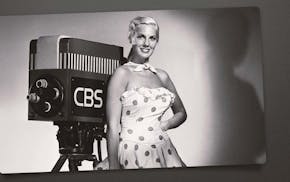It looked as if it were going to be the Osmo show. How often do you find someone filling the role of conductor, composer and clarinetist on one program? That's what Minnesota Orchestra music director Osmo Vänskä did this weekend for the final concerts of the orchestra's 2020-21 season.
But surprise: Vänskä had the concert stolen out from under him. Yet considering that his wife did the stealing, he probably didn't mind.
The orchestra's concertmaster, Erin Keefe, was the soloist for Kurt Weill's Violin Concerto. And, on Friday night, she turned in the most commanding and confident performance by a soloist I've experienced since live audiences became a thing again. She took a very demanding work that can sound somewhat confounding in some hands and made it exhilarating with her fiery, flamboyant interpretation.
Not to take anything away from Vänskä's impressive trifecta. While Twin Cities concertgoers know him as an imaginative and exciting conductor, he periodically reminds local audiences that his professional career began as an orchestral clarinetist. On Friday, he was one of nine musicians onstage for Samuel Coleridge-Taylor's Nonet in F Minor, a work the teenage composer wrote in 1893.
In some ways, Coleridge-Taylor sounds ahead of his time; it's easy to imagine the schmaltzy and effervescent Nonet as a soundtrack for some Hollywood romance of the 1930s or '40s. And the solos proved the chief pleasure of the piece, allowing enjoyable moments in the spotlight for not only Vänskä but pianist Mary Jo Gothmann and fourth-chair French horn player Bruce Hudson.
Among those aforementioned three C's Vänskä could put before his name Friday night, the newest role was composer. At the center of the program was the premiere of his Overture, a work he wrote while under the influence of the Weill Violin Concerto. Just as that work's instrumentation is mostly winds and percussion, so is Vänskä's Overture.
The title suits it. Just as an overture is often a collage of themes from the stage work it precedes, Vänskä's piece offered a montage of melodies and shifting moods. It's also a fine showcase for the orchestra's percussion section.
Weill may be best known for such songs as "Mack the Knife" and "September Song," but most of his 20s were spent in classical composition. At 24, he wrote his Violin Concerto, and I may never experience a more eloquent and involving version of it than the one offered Friday night.
Keefe was asked to execute long phrases of fast, agitated bowing, often while one soloist or another sang out legato lines above her. But never were her expressions of anxiety and tension more pronounced than on the "Cadenza" at the work's center, a movement in which Weill takes the conventions of a classical concerto's cadenza and turns them upside down and sideways.
Several soloists joined Keefe in engaging musical conversation, rising as one united ensemble on the finale. Speaking of rising, that's what the audience did at the concert's conclusion. And deservedly so.
Rob Hubbard is a freelance classical music critic. • wordhub@yahoo.com
It was once a center of Islamic learning. Now Mali's historic city of Djenné mourns lack of visitors
At Memphis BBQ contest, pitmasters sweat through the smoke to be best in pork
Landslide forces closure of iconic Southern California chapel designed by Frank Lloyd Wright's son


